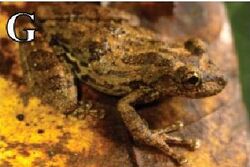Biology:Scinax tropicalia
| Scinax tropicalia | |
|---|---|

| |
| Scientific classification | |
| Domain: | Eukaryota |
| Kingdom: | Animalia |
| Phylum: | Chordata |
| Class: | Amphibia |
| Order: | Anura |
| Family: | Hylidae |
| Genus: | Scinax |
| Species: | S. tropicalia
|
| Binomial name | |
| Scinax tropicalia Novaes-e-Fagundes, Araujo-Vieira, Entiauspe, Roberto, Orrico, Solé, Haddad, and Loebmann, 2021
| |
| Synonyms[1] | |
| |
Scinax tropicalia, or Tropicalia's snouted treefrog, is a frog. Scientists report two distinct populations, both in Atlantic forest in Brazil . It lives no more than 600 meters above sea level.[2][3][4][1]
Habitat
This frog lives in forests on the Atlantic side (east side) of Brazil.[1]
Appearance
The adult male frog is 30.8 to 39.7 mm long in snout-vent length and the adult female frog is 35.3 to 44.1 mm long. Its chest and belly are yellow and its throat is orange. This frog is brown in color with darker brown marks and mottled, interrupted stripes going down its body. It has dark brown bars on its inner legs, outer legs, and all of its front and back toes.[1]
The pupils of the frog's eye are horizontal. It has vomerine teeth in its jaw. The frog's upper front leg is less muscular than its lower front leg, and its front feet are proportionately large. It has disks on its front and back toes, but the hind feet have more webbing than the front feet.[1]
Call
Scientists noted that the male frog makes three kinds of sounds: It has a short, single-note advertisement call that it uses to announce its presence to females. Scientists also heard the male frog make a squeaking antagonistic call when another male frog came too close or attempted amplexus. Another male made a longer antagonistic call when, while in amplexus with a female, another male tried to push it away.[1]
Etymology
This frog is named for its habitat but also for the tropicália, or tropicalismo movement, which began in the 1960s and includes many Brazilian musicians.[1]
References
- ↑ 1.0 1.1 1.2 1.3 1.4 1.5 1.6 Novaes-e-Fagundes G; K Araujo-Vieira; OM Entiauspe-Neto; IJ Roberto; VGD Orrico; M Solé; CFB Haddad; D Loebmann (2021). "A new species of Scinax Wagler (Hylidae: Scinaxini) from the tropical forests of Northeastern Brazil". Zootaxa 1 (4903): zootaxa.4903.1.1. doi:10.11646/zootaxa.4903.1.1. PMID 33757103. https://www.researchgate.net/publication/348250452. Retrieved May 25, 2022.
- ↑ Frost, Darrel R.. "Scinax tropicalia Novaes-e-Fagundes, Araujo-Vieira, Entiauspe, Roberto, Orrico, Solé, Haddad, and Loebmann, 2021". American Museum of Natural History, New York. https://amphibiansoftheworld.amnh.org/Amphibia/Anura/Hylidae/Scinaxinae/Scinax/Scinax-tropicalia.
- ↑ "Scinax tropicalia". University of California, Berkeley. https://amphibiaweb.org/species/9312.
- ↑ Marinho; Novaes-e-Fagundes; Orrico; Araujo-Vieira (October 26, 2021). "The tadpole of Scinax tropicalia Novaes-e-Fagundes et al. 2021 (Hylidae, Scinaxini)". Zootaxa (Zootaza) 5057 (4): 590–596. doi:10.11646/zootaxa.5057.4.9. PMID 34811189. https://mapress.com/zt/article/view/zootaxa.5057.4.9. Retrieved May 25, 2022.
Wikidata ☰ Q104707850 entry
 |

